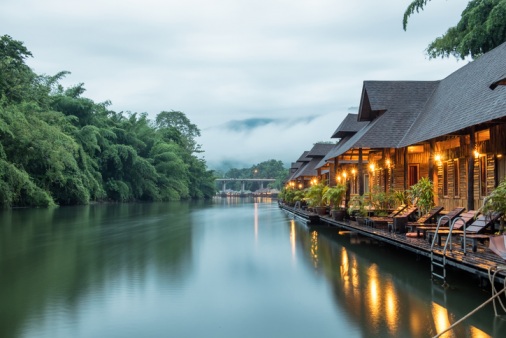Could floating cities be the answer to rising sea levels and overcrowded cities

Architects are devising ever more radical solutions to rising sea levels and overcrowded cities. Whole communities living on floating platforms – in the so-called blue belt – could be the answer.
As sea levels rise around the world, more humans will end up living on the water. The prospect of whole cities anchored in sheltered bays, lagoons or marinas is closer than we might imagine. Leading architects are now rising to the challenge and designing floating conurbations of the future.
Italian designer Pierpaolo Lazzarini is a good example. He has come up with an idea for a floating hotel of pyramid-style structures – a fusion of Mayan architecture, ancient Egypt and Japanese temples. Although it’s only at concept stage, the plan is for it to be entirely self-sufficient, providing luxury hotel pods for citizens looking to escape the dry land.
Called Wayaland, it would feature pyramids sitting on 3,000-square-metre floating basement units, each with an entry port for boats, and topped with ten floors that would extend 30 metres above the waterline.
Not to be outdone, fellow Italian architect Carlo Ratti has proposed an idea for a floating plaza off the coast of West Palm Beach, in the US state of Florida. His design relies on a semi-submersible platform that sits partly under the sea surface thanks to a system of responsive air chambers similar to those used by submarines. Ratti says he aims to “showcase how a new technology allows us to radically redefine the relationship between architecture and water”.
If his plans take shape, the good citizens of West Palm Beach will be able to stroll from their city centre onto the plaza in the middle of a lagoon. As they enjoy restaurants and swimming pools above the water, a series of air chambers below will automatically open and close, releasing or taking in water according to the number of people on board.
Across the other side of the Atlantic, Danish architects BIG have proposed a sustainable floating community. Designed as a man-made ecosystem, Oceanix City aims to create a blueprint for a modular maritime metropolis.
The largest structures are kept below seven storeys to retain a low centre of gravity that will resist a tropical storm. Pods can be prefabricated and towed into docks to join with others, growing from a village for 300 people into a city for 10,000, multiplying like a “culture in a petri dish”.
Bjarke Ingels, founding partner of BIG, explained the mounting need for aquatic construction. “Nine out of ten of the world’s largest cities will be exposed to rising seas by 2050. The sea is our fate; it may also be our future. The architecture can grow, transform and adapt organically over time, with the possibility of scaling indefinitely to provide thriving nautical communities for people who care about each other and our planet.”
On this verdant archipelago, inhabitants will eat only plants and fish, as there is no space for cultivating farm animals.
Gardens, orangeries and hydroponic greenhouses will provide a rich supply of fruit and vegetables. Below sea level, floating reefs, seaweed, oysters, mussels, scallops and clams will clean the water and create new habitats for other marine life.
Bjarke Ingels, founding partner of BIG, explained the mounting need for aquatic construction. “Nine out of ten of the world’s largest cities will be exposed to rising seas by 2050. The sea is our fate; it may also be our future. The architecture can grow, transform and adapt organically over time, with the possibility of scaling indefinitely to provide thriving nautical communities for people who care about each other and our planet.”
BIG is also designing affordable student housing using repurposed shipping containers that can float in the waterways of major cities.
The view that floating accommodation should not become a privilege of the rich is shared by Richard Coutts, founder of London-based architects Baca. Although his firm is involved in the design of luxury aquatic structures – such as the 50 eco lodges that will float amongst the reed beds around the £25million Tyram Lakes hotel resort in Yorkshire, in northern England – Coutts is also excited about the vast potential for more affordable homes in city centres.
“How we inhabit a future with increased rainfall, increased sea levels and increased threat of flooding is central to our work,” he says.
“As a society, we need to learn how to work better with water. When you live on water, you not only get magnificent views from your house, but you are also safe from the impacts of climate change. It just makes sense.”
He believes that improvements in technology and design in recent years will open the floodgates on aquatic living. “We’ve moved forward as an industry, demonstrating a proof of concept.
Today, it’s no longer about how, but how many, as we look towards mass production. If you consider the UK alone, there are 200 linear miles of redundant canals, with acres of unused dock areas. This represents real value for money, especially for cities looking to provide affordable housing for key workers. With the degeneration of town centres and their high streets, floating homes offer a different way of attracting families into the urban heartland.”
Stubborn land lubbers may prefer solid ground beneath their feet. However, Coutts is confident that sceptics will quickly embrace life on water.
“You are in the fresh air, more closely connected to the weather and nature. You literally sway to the rhythm of the world around you,” he says. “We know from research that these views can help the healing process and speed the recovery rate in hospitals. There are clearly health benefits to aquatic living.”
Imagination is in ready supply, but it will take a different mindset from policy-makers and mortgage providers to translate these good ideas into genuine alternatives to land-based settlements.
Instead of fighting the sea with flood defences and land reclamation, the answer may lie in embracing undeveloped stretches of water on the edge of our cities. Not so much the green belt as the blue belt.
Authored by MS Amlin
About MS Amlin
MS Amlin is a leading global specialty commercial insurer and reinsurer with operations in the Lloyd’s, UK, Continental European and Bermudian markets.
Comprising Mitsui Sumitomo’s London and Bermuda-based operations and the historic Amlin businesses, MS Amlin specialises in providing insurance cover for a wide range of risks to commercial enterprises and reinsurance protection to other insurers around the world.
It is wholly owned and fully supported by the financial strength and scale of MS&AD of Japan, the eighth largest non-life insurer in the world. To learn more, visit www.msamlin.com.

